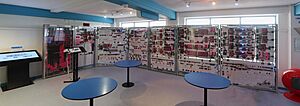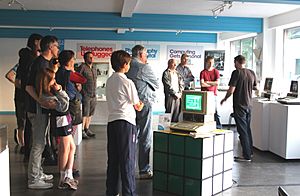Centre for Computing History facts for kids
 |
|
| Established | 2007 |
|---|---|
| Location | Cambridge, Cambridgeshire |
| Type | Computers |
| Public transit access | Newmarket Road |
| Nearest car park | On site |
The Centre for Computing History is a cool computer museum located in Cambridge, England. It was created to show everyone the amazing story of how computers and technology have changed our world, from the past to today.
Contents
Discover the Computer Museum
This museum is like a treasure chest for old computers and related items. You can visit from Wednesday to Sunday during school terms. During school holidays, it is open every day.
Inside, you will find important computers from the early days. These include old calculating machines called comptometers. You can also see famous computers like the Altair 8800, ZX Spectrum, and Apple II.
The museum also has many old video game consoles. There are also computer parts, software, and a huge collection of computer books and magazines. One of the coolest things there is the Megaprocessor. It is a giant version of a computer chip, designed by James Newman.
How the Museum Started
The Centre for Computing History is a special kind of charity that focuses on education. It gets money from local businesses and people who want to support it.
A famous investor named Hermann Hauser helped with the funding. He became a supporter of the museum in December 2011. This was 30 years after the popular BBC Micro computer was launched. A group of trustees, led by Gareth Marlow, helps run the museum.
Moving to Cambridge
The museum moved to a bigger place in Cambridge in summer 2013. This new spot is about 10,500 square feet. Before this, the museum was in a town called Haverhill, Suffolk.
In October 2011, there were talks about moving the museum to Cambridge. By June 2012, they got permission to build at the new Cambridge site.
Museum Recognition
In March 2019, the museum earned a special award. Arts Council England (ACE) gave it "Accredited Museum status." This means the museum meets high national standards. It helps people trust the museum and helps it get funding.
In December 2022, Lisa McGerty became the new CEO and Curator. She used to be a project manager there.
In November 2019, the museum won an "Object of The Year" award. This was for their Sinclair ZX Spectrum prototype. A company that worked on the computer's development had donated it.
In July 2024, the museum was named a top attraction. It received a 2024 Tripadvisor Traveller’s Choice award.
Fun Activities and Projects
The Centre for Computing History offers many educational activities. These are for schools and for everyone else. You can learn to program old BBC Micro computers from the 1980s. You can also take tours about gaming. They even teach coding using software like Scratch for the Raspberry Pi.
Helping TV and Movies
The museum also lends old items for TV shows and movies. They helped with props for shows like The IT Crowd. They also worked on Brits Who Made the Modern World with Peter Snow. In April 2009, they created the Gadget Hall of Fame stand. This was at The Gadget Show Live exhibition in Birmingham. In December 2018, the museum helped with a special Netflix episode. It was an interactive episode of Black Mirror called Bandersnatch.
Preserving History
The museum collects and saves old computer items. They worked on a project to save data from the BBC Domesday Project. This project aimed to make the data available online. They already have data from two parts of the project online.
The oldest working machine at the museum is their Elliott 903. They often show how it works. Other important items include a prototype ZX Spectrum. They also have Professor Steve Furber's Computer Group prototype. Another cool item is a NeXT computer signed by Sir Tim Berners-Lee.
In June 2017, some museum volunteers were recognized. They received awards for their hard work at the SHARE Museums East Volunteer Awards.
Special Events and Partnerships
In 2017 and 2018, the museum took part in Butlin's Astonishing Science weekends. They showed a timeline of computers and consoles. This helped people see how technology has grown over the years. They also had BBC Micros and Raspberry Pis. Visitors could complete programming tasks, like controlling robots.
In October 2018, the museum got money from the lottery. This was for a project about LEO computers. They worked with the LEO Computers Society. The project is called "Swiss Rolls, Tea and the Electronic Office: A History of LEO, the First Business Computer." It aims to collect and share the story of LEO. This includes old items, documents, and personal memories. The project also plans to create a virtual reality version of the LEO I computer.
In September 2024, the museum worked with Orca Scan and Datalogic. They launched a temporary exhibition. It celebrated 50 years since the first retail barcode was scanned. The "History of Barcodes" exhibition showed how important barcodes are. They connect a physical product to its digital information.
The Esmée Fairbairn Collections Fund gave the museum a grant. This was £93,200 for a two-year project. The project, called 'Broken Tech: Broken Earth', started in November 2024. It helps local people learn about how technology affects the environment and society.
Saving Video Games
The museum has a huge collection of over 13,000 video games. They also have a leading project to save video games. You can find information about every item in the museum online. As part of saving games, they digitally store the original code. This includes games like the Magic Knight series by David Jones (programmer). They also save scans of original drawings and other development materials. This includes items from game companies like Guerrilla Games.
Their work shows how important it is to save everything about a game. This includes marketing materials, packaging, and even how copy protection worked. The museum also collects rare computer hardware and operating systems. They also work with today's video game makers. They act as a place to keep their current work safe for the future.



